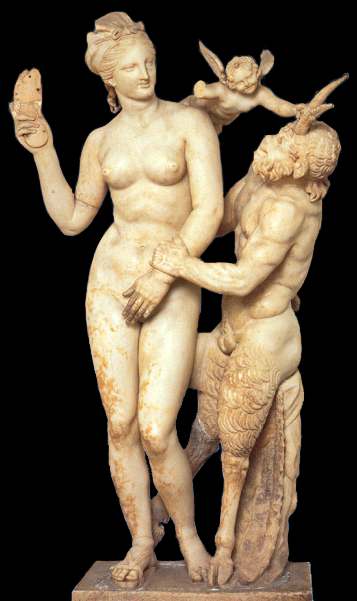
I can hear the groans at my feeble pun, but couldn’t resist. In actual fact, alcoholic beverages -- taken in moderation -- are the only aphrodisiac that generally work, at least when taken in moderation. Unfortunately, most people don't quit while they're ahead (leading to some forgettable encounters for many of us, I'm sure). Even Shakespeare acknowledged that alcohol, to paraphrase Macbeth, increases the desire but takes away the performance."
Fetch me that flower,Almost any edible (and some marginally edible) thing has been considered an aphrodisiac at some point in history. And in most eras, the medical or scientific philosophy of the day was used to shore up these beliefs. In ancient Rome, a physician named Galen believed that any "warm and moist" food could be an effective stimulant, provided it also produced "wind" -- in other words, flatulence. Personally, I'm not sure the rewards would be worth the obvious down side. Nevertheless, up through the eighteenth century, Galen's theory held sway, which made asparagus, mustard, anise, nettles and sweet peas popular aphrodisiacs for centuries.
the herb I show'd thee once;
The juice of it on sleeping eyelids laid
Will make man or woman madly dote
Upon the next live creature that it sees.
--Oberon, A Midsummer Night's Dream
The word aphrodisiac comes to us from Aphrodite, goddess of sexuality and
_I_IMG_7881.jpg) romantic love. According to legend, Aphrodite considered sparrows sacred, and the ancient Greeks thought sparrows were especially lustful (in much the same way some Americans view rabbits). Because of the association with Aphrodite, Europeans were inclined to eat sparrows, particularly their brains, as aphrodisiacs.
romantic love. According to legend, Aphrodite considered sparrows sacred, and the ancient Greeks thought sparrows were especially lustful (in much the same way some Americans view rabbits). Because of the association with Aphrodite, Europeans were inclined to eat sparrows, particularly their brains, as aphrodisiacs.Because sexual function was key to reproduction, even the church got involved in the discussion of aphrodisiacs. The thirteenth century monk St. Thomas Aquinas wrote that an aphrodisiac had to produce "vital spirit" and be nutritious. In Aquinas's writings, the heartiest food -- meat -- was an aphrodisiac. Aquinas also believed that drinking wine produced the "vital spirit," a belief that persists to this day (and as noted above, has some basis in science).
Cleopatra was said (by her detractors) to have brought her lovers to their knees by the use of potions and perfumes. Today, we use the term aphrodisiac to refer to anything that inspires lust; we don't think of an aphrodisiac as a cure for sexual dysfunction or impotence. But in Galen's time, there was no distinction between lack of desire and lack of ability. Galen believed that anything capable of producing "wind" could also inflate the penis.
Of course there were also folk tales not rooted in the "sound science" of physicians like Galen. Mandrake root, which is forked and said to resemble the apex of a woman's thighs, was eaten as a cure for female infertility. One ancient aphrodisiac we recognize today is oysters, which may have come to be known as an aphrodisiac only because of their resemblance to female genitals. Few old medical texts list oysters as an aphrodisiac, although literary references are legion.
Another well known aphrodisiac is Spanish fly, used famously by Robin Schone in her breakout novel The Lady's Tutor. Among other things, the chemicals in Spanish fly irritate genital membranes, which many consider arousing. Now for the inevitable down side -- Spanish fly can cause kidney failure and gastrointestinal bleeding. Most of the historical aphrodisiacs are merely disgusting, but Spanish fly can be deadly. Based on the scenario described Schone's book, I think the heroine was in serious danger of having taken a fatal dose.
Many other reputed aphrodisiacs were equally deadly. In the Renaissance, nightshade and foxglove -- both highly poisonous -- were rubbed on a sleeping man's eyelids to make him amorous upon waking. Most of these deadly aphrodisiacs weren't ingested, probably because a dead lover was not the goal of using an aphrodisiac.
Despite all these efforts to stir the passions artificially, there is no real substitute for good old-fashioned hormones. As Ovid says in The Art of Love, after giving an exhaustive list of aphrodisiacs:
Prescribe no more my muse, nor medicines give
Beauty and youth need no provocative.
Regardless of their ages, the heroes and heroines of romance, of course, need no artificial stimulants. But I'm curious if you've seen the occasional aphrodisiac in fiction, or if there are reports of historical figures using them.
No comments:
Post a Comment